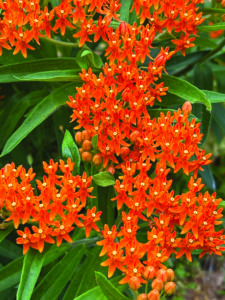
From June through August, crown-shaped, small bright-orange or yellow flowers appear in a flat cluster that floats above the butterfly flower’s foliage. (Photo by Ginny Rosenkranz)
Butterfly flower or Asclepia tuberosa used to be called the Butterfly weed, which never seemed right for this brightly colored flower that offers so much for the Monarch butterfly.
It’s very nice that this herbaceous perennial is now called the “butterfly flower!”
These bright-orange flowering plants grow in clumps to a foot to two and a half feet tall and wide, with lance shaped narrow green leaves that seem to wait until spring has finally warmed the soil to emerge and begin to grow again.
The 3- to- 6-inch-long leaves are arranged on the hairy stems in an alternate to whorled fashion, climbing up almost to the flower clusters.
From June to August, crown-shaped small, bright-orange or yellow flowers appear in a flat cluster that floats above the foliage.
The flowers mature into spindle shaped seed pods filled with silky tailed seeds that float on the airy breezes like tiny ballerinas.
The seeds will germinate quickly but the new seedling plants need to grow for two to three years before blooming.
The plants prefer to grow in medium to dry well drained soils in full sun. They are drought tolerant and slightly salt tolerant, and fit into the Shore landscape perfectly.
The butterfly flower should be planted together in threes or fives and the Monarchs will be able to find them faster if they are planted at the edges of the flower bed, with other pollinator flowers in the center of the flower bed.
Bright yellow and red flowering the native Indian Blanket flowers pare well with the butterfly flower, or plant cooler blue flowering plants like Anise Hyssop.
The beautiful flowers are not just pretty, they provide a nectar source for many butterflies and other pollinators.
The plant itself is a host for the Monarch caterpillars, the gray hairstreak, the Queen and Milkweed tussock moth caterpillars.
Don’t worry if they feast and eat the plants almost to the ground, the Butterfly flower will come back quickly to bloom again.
Like a lot of the other milkweed plants, the butterfly flower has a strong taproot that allows the plants to grow back quickly after the native caterpillar’s feast on it.
There are a lot of ways to plant the butterfly flower, in a sunny meadow, along walkways, in small spaces, in pollinator or butterfly gardens, native gardens and drought tolerant gardens.
Although the butterfly flower does not weep with white sap, care should be taken when handling these plants because when they are trimmed, the clear sap is still a latex sap — and those who have latex allergies should wear protective gloves.
(Editor’s Note: Ginny Rosenkranz is a commercial horticulture specialist with the University of Maryland Extension.)



